Much as with "Bauhaus", "Memphis" is all too often popularly reduced to a "style", something one can "recreate".
As with "Bauhaus" that it is not only disingenuous, and erroneous, but hinders development of understandings of the (hi)story of design, understandings of the path taken to our contemporary design that are important for considerations on where we are and how best to progress.
With the showcase Memphis: 40 Years of Kitsch and Elegance the Vitra Design Museum Gallery issue an invitation for us all to delve a little deeper, to look below the plastic laminated surface.
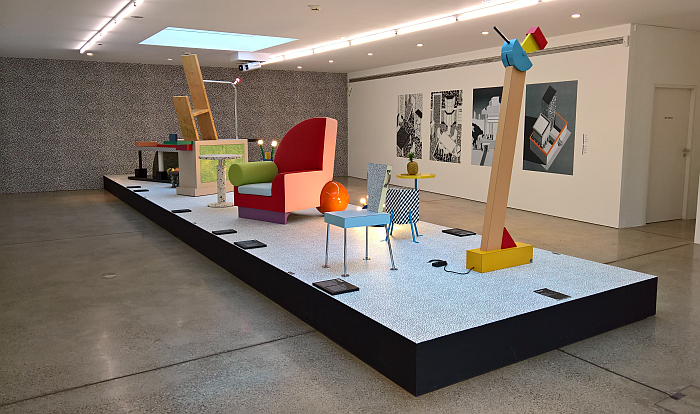
The Memphis design collective celebrated their inaugural exhibition in Milan on September 18th 1981, an exhibition in gallery Arc ’74 that has a place in the annals of design (hi)story every bit as fabled as the objects presented; and an exhibition that for all it appeared to burst forth out of the blue, ¿Blues?, was a moment that had been developing for many, many, years. Ettore Sottsass the guiding light behind the collective, and at the exhibition's opening a 64 year old Grand Doyen of Italian design, once stated that Memphis had been ten years in the making1; we'd respectfully suggest a little longer, would respectfully suggest that Memphis was a moment in an international discourse on design that had begun in the early 1960s and to which Sottsass had been one of the more interesting, idiosyncratic, contributors.
A developing moment that came together over the course of three evenings in December 1980 at a series of gatherings in Sottsass and Barbara Radice's Milanese flat in the company of a group of young architects; young architects, as with Sottsass, unhappy with where contemporary architecture and design was, and questioning how best to proceed. And where, so the story goes, one evening, as the idea to develop a collective cooperation became more tangible, Bob Dylan's Stuck Inside of Mobile with the Memphis Blues Again played on endless repeat in the background, a track from Dylan's 1966 Blonde on Blonde album, a wondrously upbeat tale of despair and hopelessness set in the city of Mobile, Alabama, and from which Sottsass, so the story goes, took Memphis for the group's name on account of associations with two disparate Memphi: the ancient Memphis the, in effect, first capital of Egypt, a city inextricably linked to the deity Ptah, the patron of craftsmen and architects; and the contemporary Memphis, Tennessee, and not just its Blues, but wider Americana in its, well, various shades of kitsch and elegance.
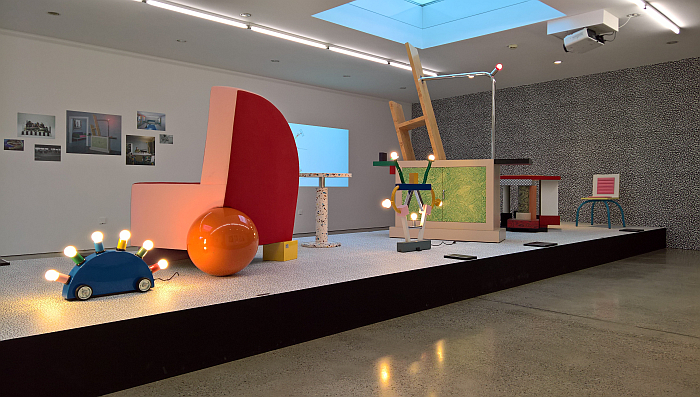
In addition, and for the sake of illustration, as a rhetorical tool, and not by way of repeating a fact, which it isn't, it's just us, just the way we think, there is also a very nice wordplay involving the Mobile, Alabama where Dylan's narrator is stuck: Mobile is Italian for furniture, Europe's biggest furniture fair is the (¿desperate and hopeless?) Salone del Mobile in Milan, and thus the desperate and hopeless Stuck Inside of Mobile with the Memphis Blues Again leads into a very simple image of being stuck with desperate and hopeless Mobile and nothing to do but
"sit so patiently, Waiting to find out what price, You have to pay to get out of Going through all these things twice".
A desperate, endless, hopelessness from which, as with Dylan's narrator, to be in Memphis is to free oneself.
Or as Barbara Radice, who was responsible for much of the organisation and publicity of Memphis, wrote in 1981, "in design, change means freeing oneself from the functional type of sophisticated design that established itself in Italy especially in the 50s and grew into the present international "good" or "real" design. It also means a move away from the radical aesthetic which tried to severe links with that very tradition in the 60s and 70s".2 Thus for Memphis the way forward is neither the reduced, rational, ornament-free continuation of inter-War positions, as exemplified by West German gute Form, but also not the Pop Art design or Radicalism with their unapologetic frontal attack on previous design positions. The way forward is something else.
An understanding of itself which helps explain that Memphis wasn't intrinsically part of anything, other than the ongoing international design discourse of which it was very much an integral part, and rather was a new contribution to that discourse; was a collective of designers seeking its own answers to contemporary questions in furniture and domestic design.
Or rather was a collective of designers seeking their own answers, for as Radice notes "Memphis is unique in not presenting itself as a homogenous movement or school."3
Whereby we'd argue that Memphis wasn't unique, Bauhaus also wasn't homogenous. That both Memphis and Bauhaus are today considered homogenous, that both are popularly reduced to a universal understood style, that can be "recreated", being but one of the many connections between the two.
And a lack of homogeneity in Memphis design discernable in 40 Years of Kitsch and Elegance.
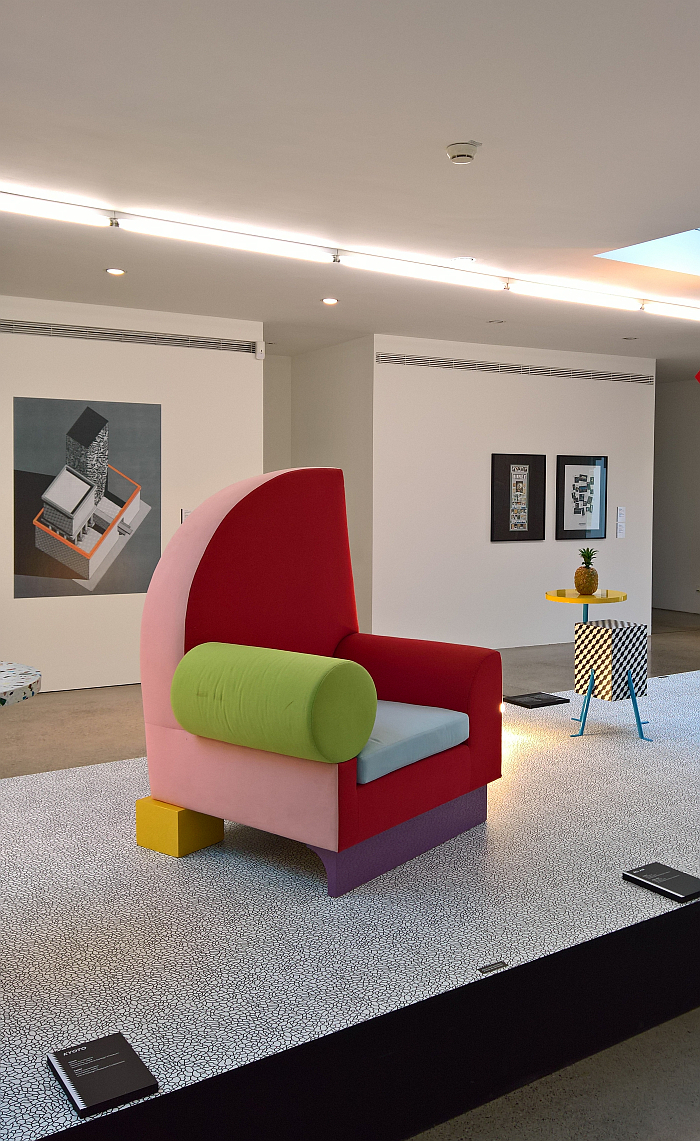
The dominant visual feature of 40 Years of Kitsch and Elegance is a presentation of a dozen or so Memphis objects from Memphis's early years, and one from Sottsass's pre-Memphis years which help illustrate that he had been on the path to Memphis for while before arriving. And while it's very easy to let yourself get distracted and to become focussed on the objects, just as important a component of 40 Years of Kitsch and Elegance is what is on the walls around the objects: documents, photographs and texts which help take your focus away from the objects and towards Memphis. For all the texts by Barbara Radice which discuss both the complex relationship between Memphis and fashion, and also the colour, materials, decoration and plastic laminate which are such defining visual, physical, characteristics of Memphis, that which people tend to focus on, and which Radice helps one understand are much more defining theoretical characteristics of Memphis, that which people should focus on; for all that Memphis claims to be non-academic design, it is very theoretically laden design, theory that one has to engage with, not to understand the furniture, everyone can, will and does develop their own natural understanding of the furniture, but to understand Memphis. The presentation format of 40 Years of Kitsch and Elegance effortlessly reassuring you that one shouldn't fear that theory. And might even enjoy it.
While beyond Memphis, 40 Years of Kitsch and Elegance also allows for further reflections on the (hi)story of furniture design, or perhaps more accurately allows Memphis to be used as a conduit for further reflections on the (hi)story of furniture design.
Reflections, for example, on Italian Design. Or ¿Italian Design? The question of "national" design in general. For all that Memphis arose in Milan, and arguably could only have arisen in Milan, and could only have arisen in Milan in the company of Ettore Sottsass and his decades of critical considerations on relationships between individuals, societies and objects of daily use; from the 16 creatives represented in the first Memphis collection, only 6 are Italian, the majority being a mix of French, English, American, Japanese and Spanish creatives. An international mix that joyously underscores that while in centuries past one could have confidently spoken of Italian Design or Danish Design or Martian Design, etc, as the 20th century moved ever closer to and then became the 21st century, such terms became increasingly meaningless as both society became ever more global and designers became ever more Mmobile; meaning that positions to and understandings of design became less rooted geographically and more rooted in the individual creative. Which isn't to deny regional accents and dialects in design, is to say that today design comes from a country rather then being intrinsically off that country. Similarly while Bauhaus was without question an awful lot of Germans, Wassily Kandinsky was Russian, Marcel Breuer was (Austro-)Hungarian, Hannes Meyer was Swiss, to name but three prominent Bauhäusler who weren't. For all that Bauhaus is considered German, that is only partially correct.
Reflections on, for example, Postmodernism, that moment in international architecture and design of which Memphis is regularly held up as a textbook example. As we noted from Anything Goes? at the Berlinische Galerie, Berlin, Postmodernism isn’t as simple to define as it often is, something tending to be underscored by the variations expressed in and exemplified by the dozen or so works on show in 40 Years of Kitsch and Elegance, by that aforementioned, and popularly overlooked, heterogeneity in Memphis that is so discernable in 40 Years of Kitsch and Elegance. Discernable, for example, in a return to and repetition of classical formal elements and geometry in unfamiliar contexts and tones, as exemplified by the Tartar table and Murmansk bowl by Ettore Sottsass, objects that could have come from the ancient Memphis of Ptah, but also couldn't have; discernable in a return to the Expressionism that preceded Modernism, or at least preceded a Modernism, Peter Shire's Bel Air lounge chair, for example, could be a Kandinsky painting; discernable in an attempt to develop new relationships in and new constructive principles of objects, Michele De Lucchi's Riviera chair being without question a side chair, but not one you would have ever seen in 1981; or discernable in those objects that appear to have been knocked together from that which was available, more bricolage than design, more intuitive gambiarra than considered design, and as exemplified by Sottsass's Beverly sideboard or Martine Bedin's Super lamp, which is, which could be straight from a Memphis, Tennessee, diner, but also couldn't be, and which for all is crying out for an update in our age of electric mobility. And thus allowing one to understand that if Memphis is to be used as a Postmodern textbook then one that explains the heterogeneity of Postmodernism rather than defining Postmodernism, and which in doing such precludes understandings of Memphis as a recreatable style.
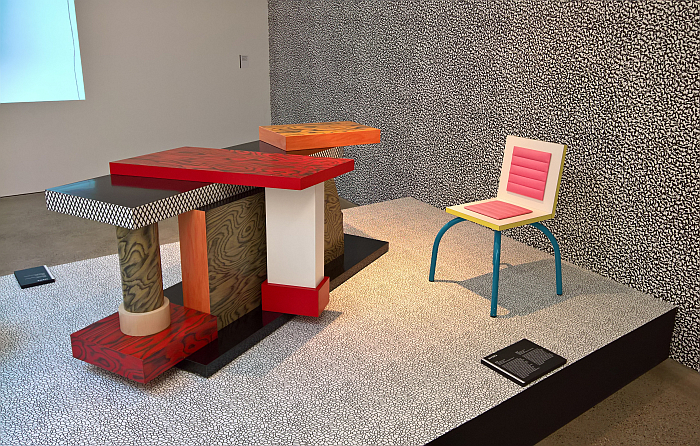
In context of 1980s architecture we opined from Anything Goes? that we may just be standing temporally too close to it to be able to fully focus on it, that more temporal distance, or reading glasses, are required to fully appreciate that which was attempted, that which was sought in the 1980s. Viewing 40 Years of Kitsch and Elegance we couldn't help thinking that with 1980s design the problem is less too little temporal distance as too much, that in context of design, whose helix tends to move at a quicker tempo than architecture's, time invariably brings with it an increasing mythologisation, falsification, commercialisation and for all objectification which tends to obscure the whats, why and wherefores of the objects. Or in the case of Memphis, hides the positions, criticisms, hopes, fears, understandings inherent in the works, hides the context and spirit of the conversations held in early 1980s Milan, every bit as thoroughly and effectively as plastic laminate
Which is why it needs to be peeled back, to enable us all to better appreciate what Memphis was; for appreciating that which Memphis was, certainly what Memphis sought to be and why, is, and as with appreciating Bauhaus beyond the easy formal cliches, not unimportant in our own age's considerations on objects of daily goods, of relationships between objects, uers and society, can inform contemporary design. Many of the questions remain when not exactly the same, then similar.
As a showcase 40 Years of Kitsch and Elegance can, by necessity of limitations of space, be no more than the briefest of introductions to Memphis, something it is very aware of and which it doesn't attempt to contradict or amend; rather it makes the most of its limited possibilities, not least through employing a collection of Memphis objects more varied than one often popularly encounters, or belive exists, to encourage you to continue yourself the considerations on Memphis collective rather than Memphis furniture it enables, to beseech you to continue the peeling away of the plastic laminate it instigates.
Memphis: 40 Years of Kitsch and Elegance is scheduled to run at the Vitra Design Museum Gallery, Charles-Eames-Str. 2, 79576 Weil am Rhein until Sunday January 23rd 2022.
In addition until Sunday September 5th 2021 the Vitra Design Museum is also presenting German Design 1949–1989. Two Countries, One History
Further details can be found at www.design-museum.de
And as ever in these times, if you are planning visiting any exhibition please familiarise yourself in advance with the current ticketing, entry, safety, hygiene, cloakroom, etc rules and systems. And during your visit please stay safe, stay responsible, and above all, stay curious……
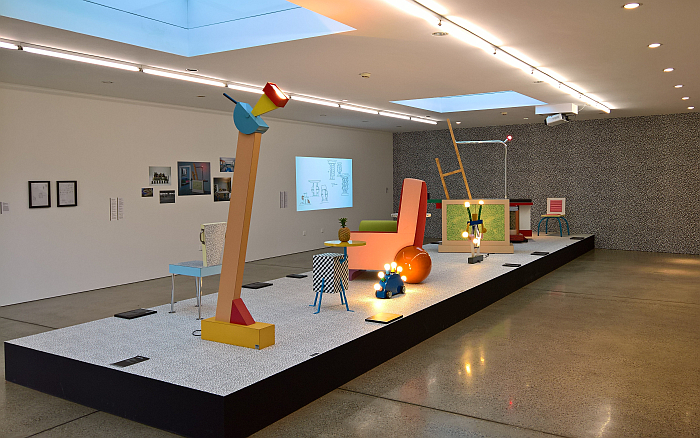
1Ettore Sottsass in conversation with Gian Piero Vincenzo in Poul ter Hofstede, Memphis 1981 – 1988, Groninger Museum, 1989
2Ettore Sottsass in conversation with Gian Piero Vincenzo
3ibid